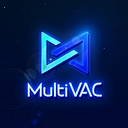Hello everyone,
Here we are, around two months after our Mainnet was released and we are about to usher in a new stage of Mainnet: Stage-ONE. Stage-ONE marks the maturity of MultiVAC’s Mainnet and the further growth of the MultiVAC ecosystem.
We have to admit, the speed of this progression has greatly surpassed our expectations. Such a great achievement belongs to the entire community!
From ZERO to ONE
In Stage-ZERO we completed the first release of the MultiVAC Mainnet, and the initiation of the All-Dimensional Sharding Flexible Blockchain came online.
Following this release, our corresponding infrastructure has been deployed one after another: The wallet, browser, and bridge are all now publicly available. Mainnet has produced more than 1.6 million blocks in total, with transactions exceeding one million in number as well. For MultiVAC, the start-up phase has been successfully completed and our next goal is to reach even higher.
What will we see in Stage-ONE?
First, the performance of MultiVAC will reach the ability to support formal applications and ensure sufficient, stable, and reliable operation. This will be the foundation for our next ecological development(s).
Second, staking on the Mainnet will become a continuous thing and we will see the emergence of new staking goals, rewards, and mechanisms in the near future.
Third, mining pools, clients, and more will have some exciting news in this stage. Friends who like to DIY should stay tuned in order to not miss this chance to experience real decentralized mining for everyone.
A new goal of Staking
Constantly challenging new goals is a very exciting thing.
After completing Stage-ZERO, the 5% reward for reaching Goal V will be distributed to everyone in the form of Mainnet tokens. This is a well-earned reward for all of those who have contributed to staking and the security of our Mainnet.
Next, our new goal is to reach three billion tokens staked. With 3,000 nodes, MultiVAC can effectively resist network fluctuations and large-scale attacks. When this goal is achieved, an extra 5% reward will be issued to all of those who participated in staking.
In the MultiVAC network, when the number of nodes reaches 3,000, the mining client can be enabled to allow every ordinary user to participate in voting as well. At this time, the entire network can be considered sufficiently decentralized and secure. Even taking into account that individual nodes will frequently go on and offline, the number of nodes in the entire network will remain sufficient at this time. Even if one-third of the nodes encounter network fluctuations or large-scale attacks, the MultiVAC network can still provide sharding services without being affected in its stability.
As our community continues to grow and we find more and more partners, we will open our staking pool service. All individuals will be able to apply to open a staking pool, and at the same time, a staking pool competition will be launched with extra rewards given to the owners of these staking pools. More information will be announced in the future, so stay tuned.
How Do I Stake?
The staking dashboard is located at https://e.mtv.ac/staking.html. Here you can find all of the guides and interfaces necessary for successful staking on the Mainnet.
Parameters
There are 50 MTV rewards per block, with a block generation rate of around 3 seconds per block (i.e. 1.44 million MTV are generated per day, which is 525.6 million MTV per year). All staked users share in the total rewards produced.
To calculate the APR of our system, it can be approximated as 86400 / 3 * 50 * 365 / total number of staked tokens * 100%. This information is also currently displayed on the staking page.
Interface
Staking itself is completed in almost real-time, while withdrawals will take 200,000 blocks (around 7 days) to confirm. The tokens issued via withdrawal will be released as Mainnet tokens.
Details
When a node ceases staking, it needs to broadcast an unstaking message to the entire network. As soon as other nodes receive this message, the first node is deleted from the voting list. If there are too many nodes exiting at the same time, then the total number of voters is insufficient. In order to avoid such a situation, a node needs to wait for a period of 200,000 blocks (about 7 days) to ensure that the online time in this period is not less than 50% (online time is based on the voting area).
A node is required to vote for at least 100,000 of the next 200,000 blocks. After the above conditions are met, the node’s unstaking behavior will be judged as successful and release its own staked tokens. If judged unsuccessful, the node’s unstaking behavior will be deemed a failure, but a new request can then be sent.
In addition, the joining and exiting of nodes is a global behavior. If nodes are allowed to join and exit at a high frequency, this will put a large amount of pressure on the total data broadcast on the entire network. Therefore, limiting the exit cycle of a node to 200,000 blocks can avoid potential DDOS attacks.
Thanks to everyone for your continued contribution.
Next, let us move on together!
ABOUT MULTIVAC:
MultiVAC is a high-throughput flexible blockchain platform based on all-dimensional sharding. It’s a next-generation public blockchain platform built for integration with large-scale decentralized applications.
MultiVAC is developing the first solution in the world characterized by speediness, efficiency, and all-dimensional sharding to expand its capacity in computation, transmission, and storage. It realizes the maximum throughput while maintaining decentralization and without sacrificing security.
Technical Whitepaper | Technical Yellowpaper | Technical Purplepaper
Listed Exchange: Kucoin.com, Gate.io, MEXC.com
Swap on DEX: Binance DEX, PancakeSwap, DODO DEX, BurgerSwap
Contact us: Email | Twitter | Telegram Group | Telegram Channel | Reddit | Discord | Facebook | Instagram
